Potrebujeme váš súhlas na využitie jednotlivých dát, aby sa vám okrem iného mohli ukazovať informácie týkajúce sa vašich záujmov. Súhlas udelíte kliknutím na tlačidlo „OK“.
ASTM G177-03(2012)
Standard Tables for Reference Solar Ultraviolet Spectral Distributions: Hemispherical on 37° Tilted Surface
Automaticky preložený názov:
Štandardné stoly Referenčné slnečného ultrafialového Spectral Distribúcia: Pologuľovitý na 37 ° naklonenej povrchy
NORMA vydaná dňa 1.11.2012
Informácie o norme:
Označenie normy: ASTM G177-03(2012)
Poznámka: NEPLATNÁ
Dátum vydania normy: 1.11.2012
Kód tovaru: NS-57536
Počet strán: 10
Približná hmotnosť: 30 g (0.07 libier)
Krajina: Americká technická norma
Kategória: Technické normy ASTM
Kategórie - podobné normy:
Anotácia textu normy ASTM G177-03(2012) :
Keywords:
global hemispherical, materials exposure, terrestrial, ultraviolet solar spectral irradiance, ICS Number Code 17.180.20 (Colours and measurement of light)
Doplňujúce informácie
| Significance and Use | ||||
|
5.1 This standard does not purport to address the mean level of solar ultraviolet spectral irradiance to which materials will be subjected during their useful life. The spectral irradiance distributions have been chosen to represent a reasonable upper limit for natural solar ultraviolet radiation that ought to be considered when evaluating the behavior of materials under various exposure conditions. 5.2 Absorptance, reflectance, and transmittance of solar energy are important factors in material degradation studies. These properties are normally functions of wavelength, which require that the spectral distribution of the solar flux be known before the solar-weighted property can be calculated. 5.3 The interpretation of the behavior of materials exposed to either natural solar radiation or ultraviolet radiation from artificial light sources requires an understanding of the spectral energy distribution employed. To compare the relative performance of competitive products, or to compare the performance of products before and after being subjected to weathering or other exposure conditions, a reference standard solar spectral distribution is desirable. 5.4 A plot of the SMARTS2 model output for the reference hemispherical UV radiation on a 37° south facing tilted surface is shown in Fig. 1. The input needed by SMARTS2 to generate the spectrum for the prescribed conditions are shown in Card ID |
Value |
Parameter/Description/Variable Name |
||
|
1 |
'ASTM UV_Std_Spectra' |
Header |
||
|
2 |
1 |
Pressure input mode (1 = pressure and altitude): ISPR |
||
|
2a |
820.0 2.0. |
Station Pressure (mb) and altitude (km): SPR, ALT |
||
|
3 |
1 |
Standard Atmosphere Profile Selection (1 = use default atmosphere): IATM1 |
||
|
3a |
'USSA' |
Default Standard Atmosphere Profile: ATM |
||
|
4 |
1 |
Water Vapor Input (1 = default from Atmospheric Profile): IH2O |
||
|
5 |
0 |
Ozone Calculation (0 = user input concentariont and altitude): IO3 |
||
|
5a |
1 0.3 |
Ozone Atltitude correctiom (IALT = 1 = > correct from sea level), Ozone Concentration (AbO3 = 0.30 atm cm) |
||
|
6 |
1 |
Pollution level mode (1 = standard conditions/no pollution): IGAS (see X1.3) |
||
|
7 |
370 |
Carbon Monoxide volume mixing ratio (ppm): qCO2 (see 7a |
1 |
Extraterrestrial Spectrum (1 = SMARTS/Gueymard): ISPCTR |
|
8 |
'S&F_RURAL' |
Aerosol Profile to Use: AEROS |
||
|
9 |
0 |
Specification for aerosol optical depth/turbidity input (0 = AOD at 500 nm): ITURB |
||
|
9a |
0.05 |
Aerosol Optical Depth at 500 nm: TAU5 |
||
|
10 |
38 |
Far field Spectral Albedo file to use (38 = Light Sandy Soil): IALBDX |
||
|
10b |
1 |
Specify tilt calculation (1 = yes): ITILT |
||
|
10c |
38 37 180 |
Albedo and Tilt variables—Albedo file to use for near field, Tilt, and Azimuth: IALBDG, TILT, WAZIM |
||
|
11 |
280 400 1.0 1367.0 |
Wavelength Range—start, stop, mean radius vector correction, integrated solar spectrum irradiance: WLMN, WLMX, SUNCOR, SOLARC |
||
|
12 |
2 |
Separate spectral output file print mode (2 = yes): IPRT |
||
|
12a |
280 400 0.5 |
Output file wavelength-Print limits, start, stop, minimum step size: WPMN, WPMX, INTVL |
||
|
12b |
1 |
Number of output variables to print: IOTOT |
||
|
12c |
8 |
Code relating output variables to print [8 = Hemispherical tilt, OUT(8)] |
||
|
13 |
1 |
Circumsolar calculation mode (1 = yes): ICIRC |
||
|
13a |
0 2.9 0 |
Receiver geometry-Slope, View, Limit half angles: SLOPE, APERT, LIMIT |
||
|
14 |
0 |
Smooth function mode (0 = none): ISCAN |
||
|
15 |
0 |
Illuminance calculation mode (0 = none): ILLUM |
||
|
16 |
0 |
UV calculation mode (0 = none): IUV |
||
|
17 |
2 |
Solar Geometry mode (2 = Air Mass): IMASS |
||
|
17a |
1.05 |
Air mass value: AMASS |
5.5 SMARTS2 Version 2.9.2 is required to generate AM 1.05 UV reference spectra.
5.6 The availability of the adjunct standard computer software (ADJG173CD5) for SMARTS2 allows one to (1) reproduce the reference spectra, using the above input parameters; (2) compute test spectra to attempt to match measured data at a specified FWHM, and evaluate atmospheric conditions; and (3) compute test spectra representing specific conditions for analysis vis-à-vis any one or all of the reference spectra.
1.1 The table provides a standard ultraviolet spectral irradiance distribution that maybe employed as a guide against which manufactured ultraviolet light sources may be judged when applied to indoor exposure testing. The table provides a reference for comparison with natural sunlight ultraviolet spectral data. The ultraviolet reference spectral irradiance is provided for the wavelength range from 280 to 400 nm. The wavelength region selected is comprised of the UV-A spectral region from 320 to 400 nm and the UV-B region from 280 to 320 nm.
1.2 The table defines a single ultraviolet solar spectral irradiance distribution:
1.2.1 Total hemispherical ultraviolet solar spectral irradiance (consisting of combined direct and diffuse components) incident on a sun-facing, 37° tilted surface in the wavelength region from 280 to 400 nm for air mass 1.05, at an elevation of 2 km (2000 m) above sea level for the United States Standard Atmosphere profile for 1976 (USSA 1976), excepting for the ozone content which is specified as 0.30 atmosphere-centimeters (atm-cm) equivalent thickness.
1.3 The data contained in these tables were generated using the SMARTS2 Version 2.9.2 atmospheric transmission model developed by Gueymard (1,2).
1.4 The climatic, atmospheric and geometric parameters selected reflect the conditions to provide a realistic maximum ultraviolet exposure under representative clear sky conditions.
1.5 The availability of the SMARTS2 model (as an adjunct (ADJG173CD3) to this standard) used to generate the standard spectra allows users to evaluate spectral differences relative to the spectra specified here.
|
Standard Solar Constant and Zero Air Mass Solar Spectral Irradiance Tables |
|
|
Simple Model for Atmospheric Transmission of Sunshine |
|
|
Standard Terminology of Solar Energy Conversion |



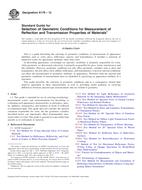 ASTM E179-12
ASTM E179-12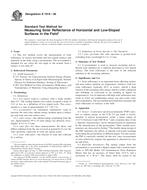 ASTM E1918-06
ASTM E1918-06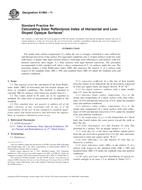 ASTM E1980-11
ASTM E1980-11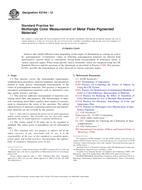 ASTM E2194-12
ASTM E2194-12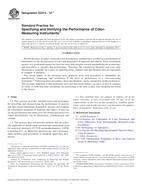 ASTM E2214-12e1
ASTM E2214-12e1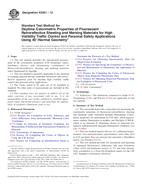 ASTM E2301-12
ASTM E2301-12
 Cookies
Cookies
